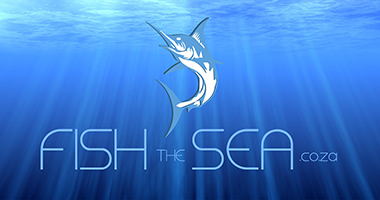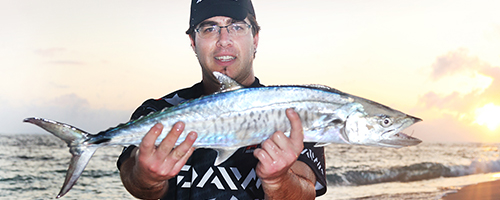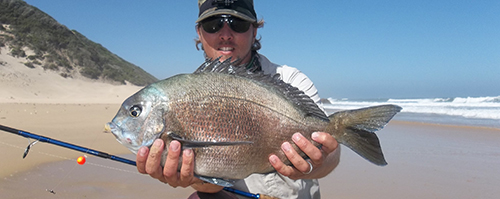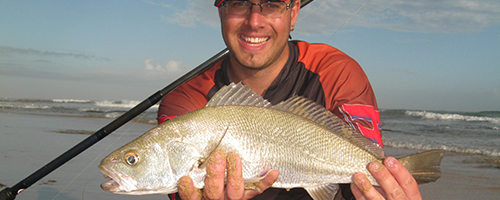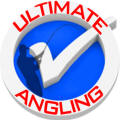Rock & Surf fishing guide for beginners & intermediate anglers
by j.r boonzaier
If you are planning a trip to the coast and you are looking for a basic
beginners guide to rock & surf fishing, then let me help you out.
As recreational anglers a trip to the waters should be an experience to
remember and therefore it is necessary for us to understand certain
aspects of angling, follow them, abide by them and ultimately live by
them. The South – African coastlines boast some of the best Rock & Surf
fishing spots in the world, and as recreational anglers it is our
responsibility to preserve them and look after them for the benefit of
everyone including future generations. This should be common practices
in any case, but unfortunately this does not always happen.
In this article I will provide beginner & intermediate R&S anglers the
information that I believe is necessary to be successful as an angler,
however with that being said; I do not in any way deem myself to be an
expert R&S angler. I am merely inputting what know and consider being
essential knowledge and practices.
1) Common courtesy towards other anglers and beach goers
Be sure to extend common courtesy on the beach as this allows for good
fishing and good times for everyone. When setting-up your fishing gear,
please avoid setting-up next to someone else when the whole beach is
open. All people especially R&S anglers like to have their own space to
fish, and unless it is completely unavoidable keep a respectable
distance from their lines. Sometimes it does happen that you cut across
someone else’s line or have someone walk into your line by accident. DO
NOT be uncivil about it, but rather give a friendly word or a bit of
advice in order to educate the offender to prevent this from happening
again. When fishing at night, do not shine bright lights onto the water,
this will annoy other anglers and also scare off fish. Most importantly,
when you are done fishing for the day be sure to leave the area where
you fished in the same condition or better than what you found it in.
Take all of your empty boxes, bottles, wrapper, line cut-offs and
anything you might have dropped with you. Respect the area and the
environment. (I myself have fished many spots around our beautiful
coastline, which has been turned into a rubbish dump by fisherman. This
is not a pretty sight and takes away from your fishing experience when
you have to endure the smell of rotting bait or dead fish left there by
others).
2) Beach Safety while R&S fishing
There are many unforeseen hazards when R&S fishing that can potentially
hurt or even kill an unsuspecting angler. Be vigilant about safety and
adhere to simple rules and common sense. “Never turn your back on the
ocean”. It doesn’t matter whether you are on the beach or on the rocks,
it only takes one wave to knock you down and sweep you into the ocean,
seriously hurting yourself or drowning. Safety should be your number 1
priority and should never be compromise.
Wading: Waders are designed to keep you warm & dry, but they can become
extremely dangerous once filled with water. Once a wader becomes filled
with water it is virtually impossible to get out of them or even swim
with them, and can lead to drowning. Most new waders do have a wader
belt which should be worn tightly around the chest area, preventing huge
amounts of water from entering the waders should you happen to slip or a
wave breaking over you.
Wading into the surf or out to a sand bar may produce more fish, but the
angler need to use extreme caution when moving into the surf wearing a
pair of waders. Wade into the surf slowly as a drop-off will occur at
some point. This drop-off will be somewhere close to the shoreline and
will range anywhere in depth from a couple of feet to a couple of feet
overhead. This drop-off can in some cases completely submerge the angler
leading to water rushing into the waders. When wading always keep an eye
on the stage of the tide. The sand bar that you waded to earlier might
end up being a long swim back at higher tide. Also be careful of
undertow, which can potentially sweep an angler out to sea. If the surf
looks like a river flowing out to sea, then it is best to avoid wading
out into the current.
Handling of fish: Even something as simple as handling a fish can pose
health hazards to the R&S angler. Aside from the obvious hazards like
teeth, fins & gill plates, dangling hooks can also pose a threat to the
unsuspecting angler. Although not all species of fish have teeth that
could cause damage, use caution until you have learnt which ones has
teeth and which ones don’t. When removing hooks from the fish’s mouth,
gently pin the fish down with one hand and use a proper hook-removal
tool or fishing pliers. Surprisingly the biggest risk to an angler is
not the fish but hook in its mouth. Sometimes a fish will shake its head
and a hook can become in-bedded into the soft tissue rather easily.
Trying to removing this hook from your hand extremely difficult and
painful due to the barb.
3) Conservation
It is our responsibility as recreational anglers to help conserve our
natural resources, and therefore it is very important for you as R&S
angler to familiarize yourself with conservation ethics. Before leaving
on your fishing excursion always find out which fish species are
in-season and which are out-of-season. Familiarize yourself with
bag-limits as well as minimum and maximum size. Like any sport or
activity the rules and regulations should be researched and adhered to
for the benefit of the species. Many anglers are under the misconception
that you can catch 10 fish from a specific specie to be on bag-limits.
In fact for many species the actual bag-limit per day is sometimes as
low as 2 or 3 fish per person, and even if you have caught multiple
different species the legal limit as a whole is only 10 fish. By
maritime conservation law a person may only be in possession of 10 fish;
whether at the beach or even in your fridge. Adhere to size-limits also;
always return a fish when it is under-size, whether it’s 10 cm under or
1 cm under. It’s the right thing to do! On the opposite side is
over-size fish. These are the breeding stock, and in many species of
fish it can take many years for them to reach sexual maturity, therefore
it is vital for an angler to return these fish in order to help ensure
the long term survival of the species. Rather keep the medium size fish;
these are better eating fish also. Only keep what you are planning to
eat that night or weekend. DO NOT go out there to catch the bag-limit,
rather enjoy the experience and only take what you need.
“Limit your catch; don’t catch your limit”
4) Necessary tackle
Rods: Graphite: Lightweight, powerful material, but susceptible to
breakage with misuse. Graphite used in higher performance rods, as less
material is necessary to create a rod with similar “strength” when
compared to other rod blank materials.
Glass: Heavy material, with slower blank tapers (softer rod), less power
compared to graphite. Handles misuse better than other rod materials.
Composite: Varying blend of graphite and glass fiber, offering a
balanced compromise of performance and durability. Lighter than glass,
but handles misuse better than graphite. It also performs (casts) better
than glass fiber but not as well as graphite.
Reels: Spinning Reels: Spinning reels offer a fixed spool requiring the
rotor and line roller (bail) to wind line around the stationary spool.
Spinning reels are much easier to cast due to the lack of need to
control a revolving spool. This is an excellent choice for both
beginners and more advanced surf anglers that desire a simple
functioning reel.
Conventional Reels: Conventional reels, also known as Bait-casting
reels, feature a spool that revolves as line is gathered on or removed
from the spool. This is somewhat difficult to cast, as the revolving
spool can create an over-spin, more commonly known as the bird’s nest
(Crow’s nest). With practice, most anglers can master the conventional
reel, minimizing most occurrences of over-spins. Conventional reels
typically offer greater casting distance and greater drag control than
spinning reels.
Basic Surf Casting Technique
Overhead/Sidearm Cast (Spinning & Conventional) is an effective cast
that lobs bait into surf. Punch/Pull Movement with hands. Punch with
“top” hand and pull with “bottom” hand. More force translates into
increased distance; however “overpowering” casts without correct
technique will prove frustrating. Technique is crucial for greatly
improved casting distance. The key to casting is proper loading of the
rod blank, enabling the rod to perform at its maximum performance level.
*Practice practice practice.
Sinkers
Knowing Which Type to Use
Anchoring Type Sinkers : Following styles of sinkers designed to dig
into the sand,
holding your bait in place. If these sinkers are moving due to rough
surf or strong tide, then a heavier weight is necessary.
Pyramid Sinkers : Most common sinker used in the surf, used in
conjunction with
chunking rigs, clam & worm rigs, and some strip baits.
Storm Sinkers : Also known as Hatteras Sinkers, this style of sinker
gives more
holding power per ounce than a pyramid sinker.
Grapnel Sinkers : More intricate sinker, that has 4-arms originating
from the
teardrop shaped lead. These arms are movable, and will lock in place.
This style of
sinker has much greater holding power than either pyramid or storm
sinkers of
comparable weights.
Bank Sinkers : Most commonly used bottom sinker, Bank sinkers have
rounded
edges. This style of sinker can be used for fishing near rocks, or
dragging rigs along
the bottom .
Drail Weights: More commonly referred to as trolling sinkers, Drail
Weights are an
inline sinker that connects to leader and line by means of bead chain or
swivel. These
are easiest sinkers to use when casting and retrieving strips of bait.
Egg Sinkers : Shaped like an egg with a hole through the center to allow
the line to
pass through so as to keep the weight in-line with leader and fishing
line. Sometimes
difficult to cast with distance due to the sinker riding up the main
line, these sinkers
allow bait to “roll” in the surf. More commonly used for live-lining,
egg sinkers
may also be used to rig plastic baits via the “Carolina-Rig” method.
Hooks & Swivels
Depending on what you are targeting, it is always good to carry a wide
variety of hooks & swivels in all different sizes.
Other necessities (Here is your basic “rock & surf fishing for
beginners” supply list)
Fishing License & Bait Collecting License: Always ensure that you are in
possession of a valid fishing license and a valid bait collecting
license should you want to collect live baits.
Rod-Holders: Prevent the rod & reel from being placed into the sand.
Tackle Box: A carry-all for bait, additional rigs, sinkers & in addition
to doubling as a seat on the beach.
Bait-Knife : To cut bait with, and please do not use the good knife from
the kitchen. Use an inexpensive bait knife rather than one from the
kitchen. This will prevent more than one argument.
Flashlight & Rod-Tip Lights: A must for night fishing, but avoid making
shadow puppets on the water with a flashlight. Fish spook easily at
night by lights shined onto water. Using rod-tip lights can help prevent
the need to shine the flashlight onto the rod tip. Lights and night time
fishing are not conducive to catching. Flashlights can be used to tie
knots or re-bait, but shield the light by turning your back to the
water. Your neighboring fishermen will appreciate it. Popular rod-tip
lights choices are glow-sticks.
Lure bags: Lure Bags are convenient for anglers plugging the beach.
Allows you to keep extra plugs by your side if you need to change lures.
Waders: Depending on time of year, waders may be crucial to fishing the
beach. Waders keep you both warm and dry when fishing during the colder
months, very important when the water temperature drops below 20C
degrees.
Pliers : A good pair of pliers facilitates removing hooks from fish.
Long nosed pliers can be convenient for deep hooked fish.
Extra rigs and sinkers : You are bound to lose a few whether from cast
off or losing fish due to broken knots or line. Not having extra rigs
and sinkers can make bait fishing very difficult.
Hook sharpener: If fishing with commercially made fishing rigs, hooks
are not sharp. They may have a point, but it will have difficulty going
through the tough jaw of some fish. Premium hooks are available, but not
usually incorporated into commercial rigs due to the cost.
Gloves: Whether for warmth in the early spring or during the colder
months of late autumn and winter, gloves can be crucial for fishing the
beach. Good choices include high quality neoprene gloves with liner or
fleece gloves.
Nail clippers : Nail clippers are probably the easiest and most
effective way to cut fishing line. Any pair will perform the job, but
the easiest to use are the larger toenail clippers with a straight
cutter. Sunscreen: Always carry a quality sunscreen with you for much
needed skin protection. UVB rays reflect off of the water, making direct
exposure to them more concentrated. Snacks & Water: Have snacks and
water handy in order to keep energy levels up and more importantly to
keep the body well hydrated.
Baits
When rock & surf fishing there are many different types of bait that an
angler can make use of. *Live baits *Chokka or Squid *Fish fillets or
Cutlet Baits *Worms *Prawns (Pink – Sand - Mud) *White mussels
*Crustaceans *Artificial baits *You can also ask the locals what to use
Problems Associated with Surf Fishing
Line-twists and wind knots: (the effect of line-twists) is a predominant
problem with spinning reels. Cause of these headaches is due to the
nature of the spinning reels and that the spool is stationary while line
is encircled onto spool by the bail. Some practices accentuate the
problem of line-twists and the accompanying wind knot.
Reeling against the drag: As a fish is taking drag, line is coming off
the spool as it would during a cast. Turning the handle as line is
stripped from the reel causes the
bail to revolve. Since line is not being gathered onto the spool, the
revolution of the
bail transfers the revolving motion to the line. Results are line-twist
and wind knot
one or two casts later. Reeling against the drag can also prematurely
burn drag
washers, making the drag feel sticky.
Retrieving Line with Little or No Tension: The lack of tension on the
line as it is
gathered onto the reel results in a loose pack of line on the spool.
This loose pack
allows the revolving bail to transfer twist to the line.
Broken Rods due to High-Sticking
High-Sticking occurs when a force (tight fishing line) acts at an angle
less than 90° to the perpendicular of the rod tip. Such forces occur
primarily in two instances when fishing; lifting fish with the rod, or
using the rod, rather than reel, to free from a snag. Either practice
will result in a horseshoe bend in the rod blank, and take the rod
beyond its intended design load. Rod blanks were not designed for this
type of dynamic force and will reach failure at some point. When they
reach failure, rods snap, typically between the second and third guide.
Reel Dropping into Sand/Saltwater
Saltwater and sand tend to destroy fishing tackle, especially fishing
reels. Once dropped into the sand or surf, fishing reels have an uncanny
knack for seizing. Perhaps not immediately, but if left unattended reels
will seize and fail to perform. Once dropped into the water or sand,
fishing reels need to be completely stripped down, cleaned, re-greased,
and put back together properly.
Tight lines to all & be safe out there.
*Conservation should always be Nr.1 priority.
